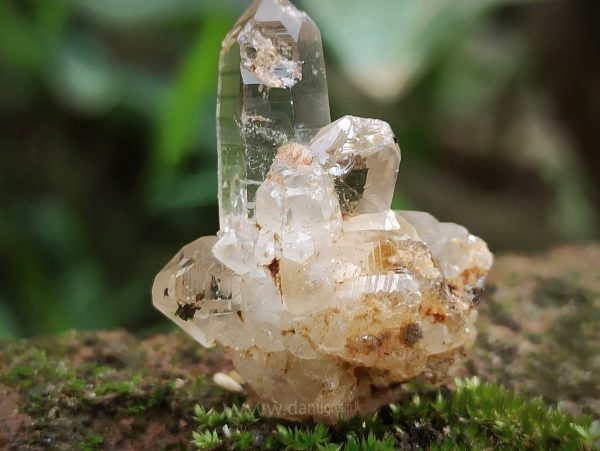
Quartz is widely distributed in nature, and its formation causes are varied. At present, the main types of quartz mineral resources include natural crystal, vein quartz, granite pegmatite quartz, quartzite, quartz sandstone, powder quartz and quartz conglomerate. Among these types, the types of deposits that can be used as high-purity quartz raw materials are mainly natural crystal, vein quartz and granite pegmatite quartz.
1. Natural crystal
Quartz crystal, also called crystal, is an important mineral raw material with the characteristics of high transparency and complete crystal shape. It is mainly composed of silicon dioxide and is mainly transparent. Due to trace impurity elements or mineral inclusions mixed into the crystal during the formation process of the crystal, these elements will meet with the internal elements of the crystal and react chemically, resulting in different colors of transparent crystals, such as purple, yellow, smoke, pink, green, red, gold, etc.
2. Vein quartz
Vein quartz is a vein mainly composed of dense quartz blocks, usually white or milky white, and the structure is mostly granular. Its silicon dioxide (SiO2) content is generally about 98%. Vein quartz ore bodies are irregular veins, with lengths usually ranging from more than ten meters to several hundred meters, and widths and thicknesses generally ranging from several meters to several dozen meters.
In terms of use, the main application area of vein quartz is the production of silicon micropowder with w(SiO2)99% to 99.9%. In addition, if the high-temperature explosion-proof technical indicators of vein quartz meet the standards, it can also be used as a raw material for metal silicon smelting. Vein quartz with uniform color, few impurities, high hardness and oily luster is also a high-quality sand material for making artificial quartz plates.
3. Pegmatite quartz
Pegmatite quartz is also known as granite quartz. Although the quartz content of granite pegmatite quartz is only about 30%, its quartz grains are very coarse and can be completely separated from the gangue after grinding, and the impurity content in the monomer quartz is extremely low.
Uses: Pegmatite quartz can be used as raw material to produce high-purity quartz.
4. Quartzite
Quartzite is a metamorphic rock, mainly formed by regional metamorphism or thermal contact metamorphism of quartz sandstone or other siliceous rocks. In addition to feldspar, mica and clay minerals, quartzite usually contains trace amounts of associated minerals such as tourmaline, hematite and zircon.
5. Quartz Sandstone
Quartz sandstone is a consolidated sedimentary sandy rock, the main components of which are quartz and siliceous debris, and the content is usually more than 95%. In quartz sandstone, common siliceous cements include opal and chalcedony, and associated minerals include a small amount of feldspar, mica and clay minerals. In addition, it may contain trace amounts of tourmaline, magnetite, ilmenite and rutile.
In terms of use, the processed products of quartz sandstone can usually meet the technical index requirements of traditional quartz application fields, and can process products with a SiO2 content close to 99%.
6. Pink Quartz
Pink quartz ore is a natural powdered quartz deposit, which belongs to the new generation of siliceous raw materials and is derived from the weathering of microcrystalline quartzite. Its main component is microcrystalline quartz, and its appearance is white, light yellow white or grayish white.
Use: Pink quartz ore is widely used in many fields, such as ceramics, insulation materials, glass fiber, plastic fillers, refractory materials, rubber, thermal insulation materials and precision casting. As a new generation of industrial mineral raw materials, it shows significant application value.
7. Natural Quartz
Natural quartz is a sandy mineral raw material with quartz as the main component, which is formed by long-term natural weathering of parent rocks such as granite, quartzite, quartz sandstone and vein quartz.
In terms of use, natural quartz sand is an ideal raw material for processing casting quartz sand, 3D printing sand, colored quartz sand and oil fracturing proppant products.
8. Quartz Conglomerate
Conglomerate is a sedimentary rock formed after the parent rock is broken, and particles with a diameter of more than 2 mm are transported, deposited, compacted and cemented. The texture of conglomerate is relatively rough, with gravel clearly visible. The main component is quartz, and it also contains a small amount of feldspar, mica, kaolin and other gangue minerals.
In terms of use, the quartz conglomerate that has been processed by a deep purification process can be used as quartz raw material for high-end automotive glass and ordinary crystal glass.
